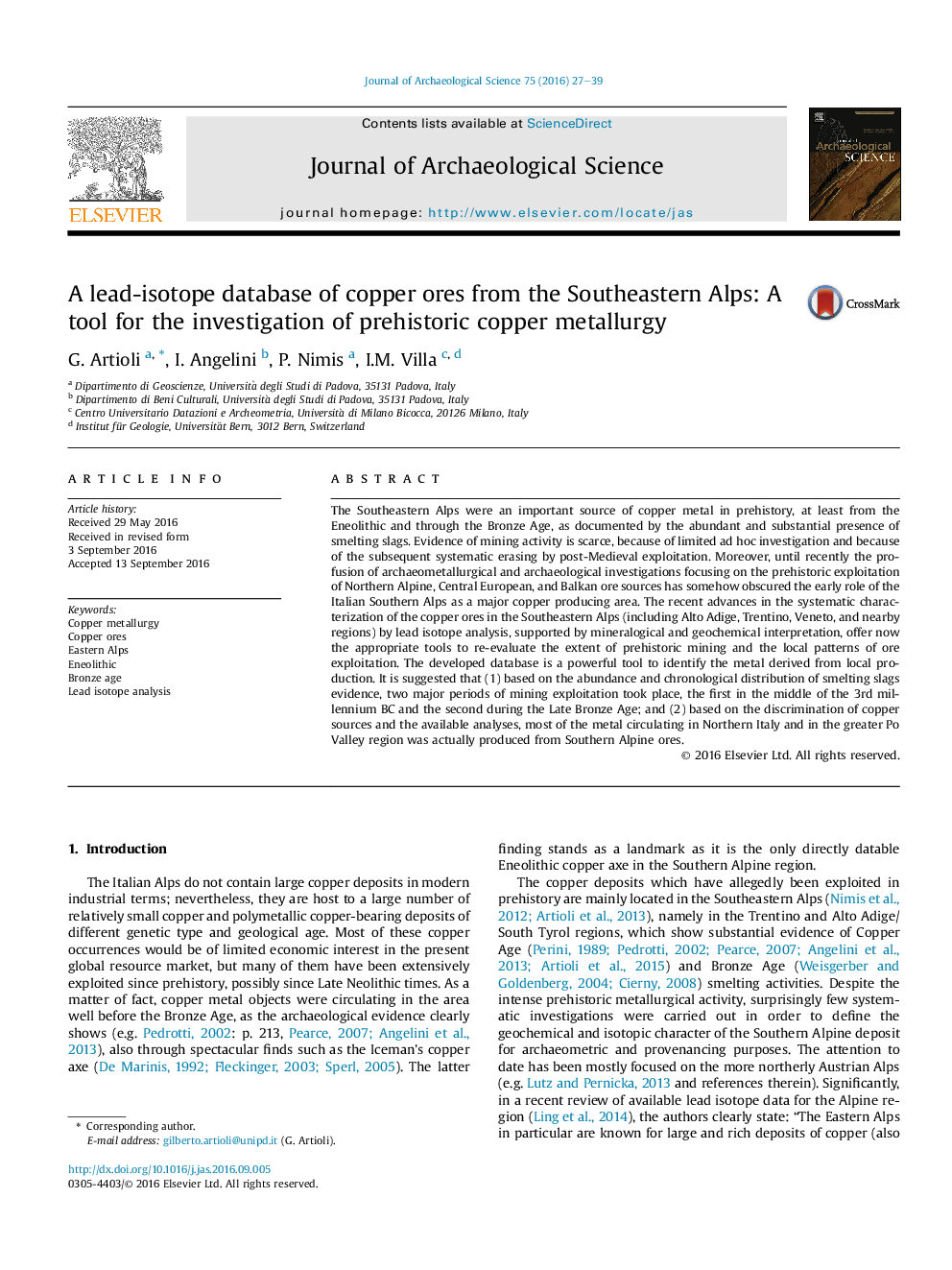| کد مقاله | کد نشریه | سال انتشار | مقاله انگلیسی | نسخه تمام متن |
|---|---|---|---|---|
| 5112115 | 1483885 | 2016 | 13 صفحه PDF | دانلود رایگان |
عنوان انگلیسی مقاله ISI
A lead-isotope database of copper ores from the Southeastern Alps: A tool for the investigation of prehistoric copper metallurgy
ترجمه فارسی عنوان
پایگاه داده ایزوتوپ سرب از کانسنگ های مس از کوه های جنوب شرقی: ابزاری برای بررسی متالورژی مس قبل از تاریخ
دانلود مقاله + سفارش ترجمه
دانلود مقاله ISI انگلیسی
رایگان برای ایرانیان
کلمات کلیدی
ترجمه چکیده
آلپ جنوب شرقی منابع مهمی از فلز مس در پیش از تاریخ بوده است، حداقل از ائونولیت و از طریق عصر برنز، به عنوان ثبت شده توسط فراوان و حضور قابل توجهی از سرباره ذوب شده. شواهد مربوط به فعالیت معدن، به دلیل محدودیت های تحقیقاتی محدود و به دلیل استثمار سیستماتیک پس از استقرار قرون وسطایی، کمیاب است. علاوه بر این، تاکنون تحقیقات باستانشناسی و باستان شناسی با تمرکز بر بهره برداری تاریخی از منابع آلپ شمالی، مرکزی اروپا و بالکان، تا حدودی نقش اولیه کوه های آلپ جنوبی را به عنوان یک منطقه تولید عمده مس شناخته است. پیشرفت های اخیر در توصیف سیستماتیک سنگ معدن مس در کوه های جنوب شرقی (از جمله آلتو آدیجه، ترنتینو، ونتو و مناطق مجاور) با تجزیه و تحلیل ایزوتوپ های سرب که به وسیله تفسیر کانی شناسی و ژئوشیمیایی پشتیبانی می شوند، اکنون ابزار مناسب برای ارزیابی مجدد گستردگی معادن ماقبل تاریخ و الگوهای محلی بهره برداری از معادن. پایگاه داده توسعه یافته یک ابزار قدرتمند برای شناسایی فلز حاصل از تولید محلی است. پیشنهاد شده است که (1) براساس توزیع فراوانی و زمانبندی شواهد ذوب ذوب، دو دوره عمده استخراج معادن، نخستین در اواسط هزاره سوم قبل از میلاد و دومین دوره در اوایل دوره برنز بود؛ و (2) بر اساس تبعیض منابع مس و تجزیه و تحلیل های موجود، بیشتر فلزاتی که در شمال ایتالیا و در منطقه دره پال بیشتر در واقع از سنگ های آلپ جنوبی ساخته شده است.
موضوعات مرتبط
مهندسی و علوم پایه
مهندسی مواد
دانش مواد (عمومی)
چکیده انگلیسی
The Southeastern Alps were an important source of copper metal in prehistory, at least from the Eneolithic and through the Bronze Age, as documented by the abundant and substantial presence of smelting slags. Evidence of mining activity is scarce, because of limited ad hoc investigation and because of the subsequent systematic erasing by post-Medieval exploitation. Moreover, until recently the profusion of archaeometallurgical and archaeological investigations focusing on the prehistoric exploitation of Northern Alpine, Central European, and Balkan ore sources has somehow obscured the early role of the Italian Southern Alps as a major copper producing area. The recent advances in the systematic characterization of the copper ores in the Southeastern Alps (including Alto Adige, Trentino, Veneto, and nearby regions) by lead isotope analysis, supported by mineralogical and geochemical interpretation, offer now the appropriate tools to re-evaluate the extent of prehistoric mining and the local patterns of ore exploitation. The developed database is a powerful tool to identify the metal derived from local production. It is suggested that (1) based on the abundance and chronological distribution of smelting slags evidence, two major periods of mining exploitation took place, the first in the middle of the 3rd millennium BC and the second during the Late Bronze Age; and (2) based on the discrimination of copper sources and the available analyses, most of the metal circulating in Northern Italy and in the greater Po Valley region was actually produced from Southern Alpine ores.
ناشر
Database: Elsevier - ScienceDirect (ساینس دایرکت)
Journal: Journal of Archaeological Science - Volume 75, November 2016, Pages 27-39
Journal: Journal of Archaeological Science - Volume 75, November 2016, Pages 27-39
نویسندگان
G. Artioli, I. Angelini, P. Nimis, I.M. Villa,
